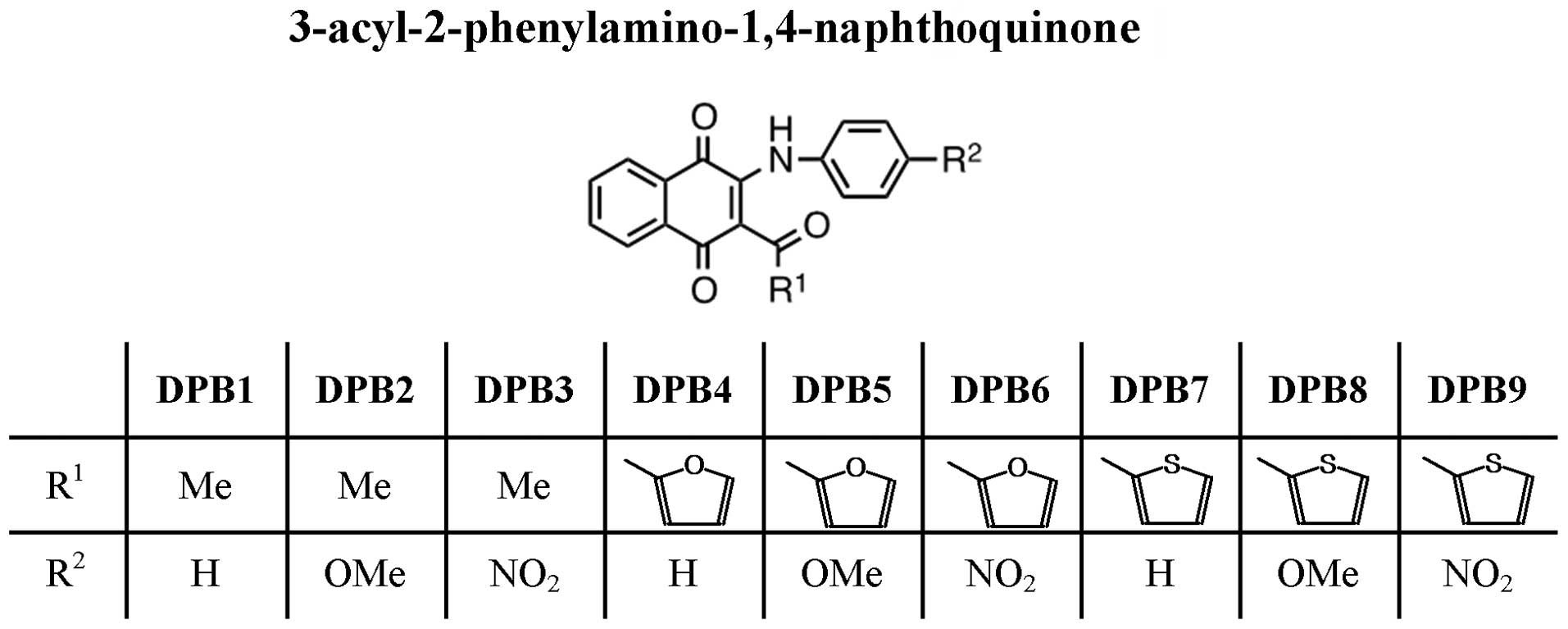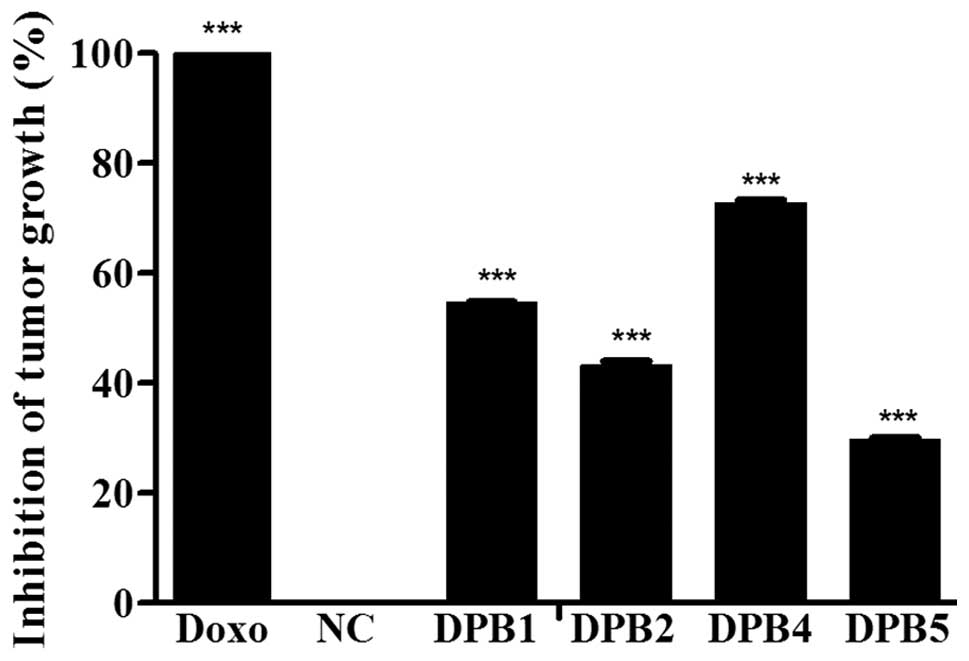|
1
|
Jemal A, Bray F, Center MM, Ferlay J and
Forman D: Global cancer statistics. CA Cancer J Clin. 61:69–90.
2011. View Article : Google Scholar
|
|
2
|
Adams VR: Adverse events associated with
chemotherapy for common cancers. Pharmacotherapy. 20:S96–S103.
2000. View Article : Google Scholar : PubMed/NCBI
|
|
3
|
Schwartz J: Current combination
chemotherapy regimens for metastatic breast cancer. Am J Health
Syst Pharm. 66(Suppl 6): S3–S8. 2009. View Article : Google Scholar : PubMed/NCBI
|
|
4
|
Nadas J and Sun D: Anthracyclines as
effective anticancer drugs. Expert Opin Drug Discov. 1:549–568.
2006. View Article : Google Scholar : PubMed/NCBI
|
|
5
|
Carvajal D, Kennedy S, Boustani A, et al:
Induction of cell death by a novel naphthoquinone containing a
modified anthracycline ring system. Chem Biol Drug Des. 78:764–777.
2011. View Article : Google Scholar : PubMed/NCBI
|
|
6
|
Gholivand MB, Kashanian S and Peyman H:
DNA-binding, DNA cleavage and cytotoxicity studies of two
anthraquinone derivatives. Spectrochim Acta A Mol Biomol Spectrosc.
87:232–240. 2012. View Article : Google Scholar : PubMed/NCBI
|
|
7
|
Zucchi R and Danesi R: Cardiac toxicity of
antineoplastic anthracyclines. Curr Med Chem Anticancer Agents.
3:151–71. 2003. View Article : Google Scholar : PubMed/NCBI
|
|
8
|
Babula P, Adam V, Havel L and Kizek R:
Naphthoquinones and their pharmacological properties. Ceska Slov
Farm. 56:114–120. 2007.(Article in Czech).
|
|
9
|
Kviecinski MR, Pedrosa RC, Felipe KB, et
al: Inhibition of cell proliferation and migration by oxidative
stress from ascorbate-driven juglone redox cycling in human
bladder-derived T24 cells. Biochem Biophys Res Commun. 421:268–273.
2012. View Article : Google Scholar : PubMed/NCBI
|
|
10
|
Smith MT: Quinones as mutagens,
carcinogens, and anticancer agents: introduction and overview. J
Toxicol Environ Health. 16:665–672. 1985. View Article : Google Scholar : PubMed/NCBI
|
|
11
|
Benites J, Valderrama JA, Taper H and Buc
Calderon P: Part 2: influence of 2-euryfuryl-1,4-naphthoquinone and
its peri-hydroxy derivatives on both cell death and metabolism of
TLT cells, a murine hepatoma cell line. Modulation of cytotoxicity
by vitamin C. Chem Pharm Bull. 57:615–619. 2009. View Article : Google Scholar : PubMed/NCBI
|
|
12
|
Benites J, Ríos D, Díaz P and Valderrama
J: The solar-chemical-Friedel-Crafts heteroacylation of
1,4-quinones. Tetrahedron Lett. 52:609–611. 2011. View Article : Google Scholar
|
|
13
|
Trachootham D, Zhou Y, Zhang H, et al:
Selective killing of oncogenically transformed cells through a
ROS-mediated mechanism by beta-phenylethyl isothiocyanate. Cancer
Cell. 10:241–252. 2006. View Article : Google Scholar
|
|
14
|
Verrax J, Beck R, Dejeans N, et al:
Redox-active quinones and ascorbate: an innovative cancer therapy
that exploits the vulnerability of cancer cells to oxidative
stress. Anticancer Agents Med Chem. 11:213–221. 2011. View Article : Google Scholar : PubMed/NCBI
|
|
15
|
Ríos D, Benites J, Valderrama JA, et al:
Biological evaluation of 3-acyl-2-arylamino-1,4-naphthoquinones as
inhibitors of Hsp90 chaperoning function. Curr Top Med Chem.
12:2094–2102. 2012.PubMed/NCBI
|
|
16
|
Mosmann T: Rapid colorimetric assay for
cellular growth and survival: application to proliferation and
cytotoxicity assays. J Immunol Methods. 16:55–63. 1983. View Article : Google Scholar : PubMed/NCBI
|
|
17
|
Günther TMF, Kviecinski MR, Baron CC, et
al: Sodium orthovanadate associated with pharmacological doses of
ascorbate causes an increased generation of ROS in tumor cells that
inhibits proliferation and triggers apoptosis. Biochem Biophys Res
Commun. 430:883–888. 2013.
|
|
18
|
Sreedhara A and Cowan JA: Catalytic
hydrolysis of DNA by metal ions and complexes. J Biol Inorg Chem.
4:337–347. 2001. View Article : Google Scholar : PubMed/NCBI
|
|
19
|
da Silveira VC, Benezra H, Luz JS, et al:
Binding of oxindole-Schiff base copper (II) complexes to DNA and
its modulation by the ligand. J Inorg Biochem. 105:1692–1703.
2011.PubMed/NCBI
|
|
20
|
Glorieux C, Dejeans N, Sid B, et al:
Catalase overexpression in mammary cancer cells leads to a less
aggressive phenotype and an altered response to chemotherapy.
Biochem Pharmacol. 15:1384–1390. 2011. View Article : Google Scholar : PubMed/NCBI
|
|
21
|
Kviecinski MR, Benelli P, Felipe KB, et
al: SFE from Bidens pilosa Linné to obtain extracts rich in
cytotoxic polyacetilenes with antitumor activity. J Supercrit
Fluid. 56:243–248. 2010.
|
|
22
|
Neidle S: The molecular basis for the
action of some DNA-binding drugs. Prog Med Chem. 16:151–221. 1979.
View Article : Google Scholar : PubMed/NCBI
|
|
23
|
Kennedy S, DiCesare JC and Sheaff RJ:
Topoisomerase I/II inhibition by a novel naphthoquinone containing
a modified anthracycline ring system. Biochem Biophys Res Commun.
408:94–98. 2011. View Article : Google Scholar : PubMed/NCBI
|
|
24
|
Verrax J, Delvaux M, Beghein N, et al:
Enhancement of quinone redox cycling by ascorbate induces a
caspase-3 independent cell death in human leukaemia cells. An in
vitro comparative study. Free Radic Res. 39:649–657. 2005.
View Article : Google Scholar : PubMed/NCBI
|
|
25
|
Deeb D, Gao X, Jiang H, et al: Oleanane
triterpenoid CDDO-Me inhibits growth and induces apoptosis in
prostate cancer cells through a ROS-dependent mechanism. Biochem
Pharmacol. 79:350–360. 2010. View Article : Google Scholar : PubMed/NCBI
|
|
26
|
Hyun MS, Hur JM, Mun YJ, Kim D and Woo WH:
BBR induces apoptosis in HepG2 cell through an
Akt-ASK1-ROS-p38MAPKs-linked cascade. J Cell Biochem. 109:329–338.
2010.PubMed/NCBI
|
|
27
|
Xu HL, Yu JF, Qu SC, Jiang YF and Sui da
Y: Juglone, from Juglans mandshruica Maxim, inhibits growth and
induces apoptosis in human leukemia cell HL-60 through a reactive
oxygen species-dependent mechanism. Food Chem Toxicol. 50:590–596.
2012. View Article : Google Scholar : PubMed/NCBI
|
|
28
|
Verrax J, Cadrobbi J, Marques C, et al:
Ascorbate potentiates the cytotoxity of menadione leading to an
oxidative stress that kills cancer cells by a non-apoptotic
caspase-3 independent form of cell death. Apoptosis. 9:223–333.
2004. View Article : Google Scholar
|















